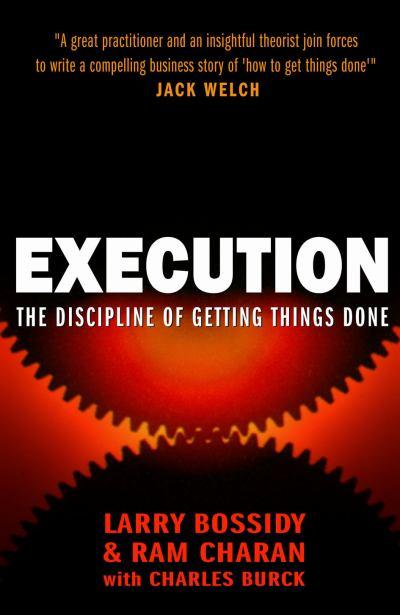
How do companies like GE, Wal-Mart and Honeywell succeed? What is the secret of Jack Welch, one of the most legendary CEO in the business world today?
The answer, according to Larry Bossidy and Ram Charan, is Execution. Subtitled The Discipline of Getting Things Done, the New York Times bestseller emphasises the importance of execution in business, how companies with an execution culture conduct their business affairs, and its three core processes: people, strategy and operations.
Laced liberally with stories from the corporate warfront, the book is heavy on pragmatism and short on management theory.
Written by former CEO and Chairman of Honeywell Larry Bossidy, and academic Ram Charan, it drives home the point that a CEO must be wholly immersed in his business – from the topmost rung of corporate strategy to the nuts and bolts of operations.
Now how could the head honcho in any organisation do this?
7 Essential Behaviours
In the section on the building blocks of execution, we’re taught that a leader needs to demonstrate 7 essential behaviours in order to thrive as an execution-focused leader.
These are:
- Knowing your people and your business
- Insisting on realism
- Setting clear goals and priorities (not some woolly pie-in-the-sky vision)
- Following through
- Rewarding your doers (not talkers!)
- Expanding your people’s capabilities through coaching
- Knowing yourself
A leader also needs to create the right framework for cultural change. She needs to set the right tone for her employees’ attitudes, beliefs and behaviours. Flowing from the top all the way down, the right culture needs to be developed and permeated across every functional group within the organisation.
Getting the right people in and building an “A” team was also highlighted repeatedly in the book as a core tenet of execution. Leaders must spend their time understanding their staff’s strengths and weaknesses, coach and mentor them. They must also be unafraid to highlight sensitive issues when the time arises.
Put In Place These Core Processes
Once the building blocks are completed, a leader must institute three core processes to build an execution-focused organisation. These are all closely inter-woven with each other, and they define the most important functions in your company.
a) The People Process
The most important process in any organisation, a robust people process evaluates individuals accurately and in depth, helps leaders to identify and develop talent, and creates the pipeline for a strong succession plan.
Leaders with a strong executional focus pays close attention to his performers and non-performers. He works strategically with his HR team to develop the talents needed to carry out the work of the organisation.
Non-performers must be adequately dealt with, while rewards in such organisations are often closely linked to business results.
b) The Strategy Process
Here, the “Hows” are just as important as the “Whys” and “Whats.”
An executional leader has an intimate understanding of her customers, competitors, environment, and critical issues.
Good strategies must consider both short (1 to 3 years) and longer term (3 to 5 years) plans, and be realistic about the organisation’s ability to implement the strategy.
c) The Operations Process
Spread out over a year with quarterly reporting (in the case of public listed companies), the operating plan needs to closely align performance targets with resources and budgets.
Execution savvy companies will develop action and contingency plans to accommodate various outcomes. They will also conduct quarterly reviews to reallocate resources to suit their varying market conditions.
Following Through – The Most Important Lesson
Perhaps the most insightful lesson I’ve learned from the book is the need for business leaders to follow through while ensuring that their people meet their promises.
Both Jack Welch and Larry Bossidy (who was also a former GE executive) regularly wrote memos to key executives after review meetings. This habit helped them to communicate key points while ensuring that milestones were met.
Unfortunately, such sterling leadership practices are virtually non-existent in most organisations.
In a world inundated with numerous management theories, Execution provides a great reminder that winning companies are not built through brilliant strategies but a relentless focus on implementation.
Its timeless lessons are relevant throughout all ages.


If you’d like a tool for managing your time and projects, you can use this web-application inspired by David Allen’s GTD:
http://www.Gtdagenda.com
You can use it to manage your goals, projects and tasks, set next actions and contexts, use checklists, and a calendar.
Syncs with Evernote and Google Calendar, and also comes with mobile version, and Android and iPhone apps.